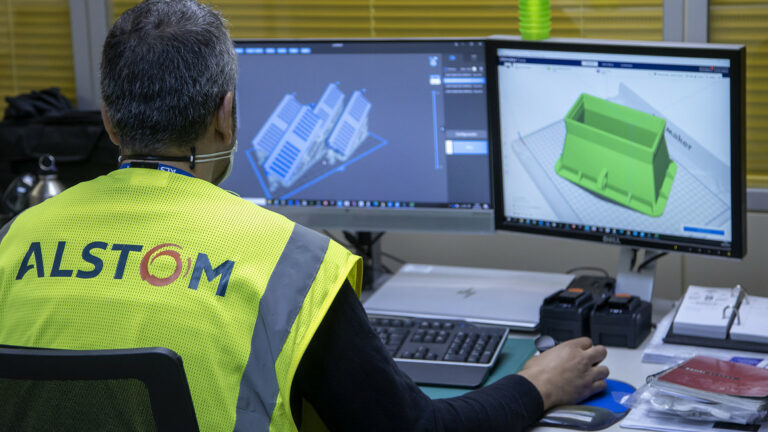3D Spark has entered into a three-year deal with the rail giant Alstom. Alstom, a transport behemoth with annual revenues of $16 billion, specializes in the manufacture of trains, trams, and high-speed trains, among other products. The company has previously utilized 3D printed components from Nexa 3D printers, employed metal filament components through Replique, and created parts using Stratasys fused deposition modeling technology. 3D Spark offers a platform that enables users to calculate CO2 savings for parts, assess the printability of components, estimate costs, and compare component costs across different technologies. It also allows for the comparison of 3D printing with alternative technologies and facilitates connections with suppliers.
Now, 3D Spark has secured a significant client in Alstom. The partnership reports that Alstom has saved $15 million by using the platform, alongside achieving a remarkable reduction of 216 years in lead times. This success has led Alstom to extend its deal with 3D Spark for an additional three years. Through the use of the Digital Factory Twin and Supplier Panel, the company can now also examine the environmental impact of parts and leverage the platform’s advanced AI tools. These tools are capable of identifying which parts should be printed in-house, thereby optimizing expenditure in this area. For Alstom’s procurement team, there has been an 80% reduction in the time taken to generate quotes. The automation of sending requests for quotation has further saved considerable time. The company asserts that these efficiencies have led to a 20% reduction in part costs. Furthermore, sustainability efforts are enhanced by accurate calculations of the Carbon Border Adjustment Mechanism carbon certificate costs, which also results in financial savings for the firm.
“Our collaboration with 3D Spark has been a key factor in Alstom’s achievements in additive manufacturing and the success of our DesignToPrint program. This partnership not only supports our innovation goals but also participates in our commitment to sustainability and operational efficiency. We look forward to furthering our leadership in the industry and setting newbenchmarks for excellence in digital manufacturing,” said Alstom 3D Printing Program Manager Aurélien Fussel.
“In an industry where trains endure up to 50 years on railway tracks, addressing spare parts and obsolescence challenges is paramount for reliability and punctuality. As leading rail operators request at least 10% of train parts to be 3D printable for digital warehousing and spare parts on demand, 3D Spark emerges as a pivotal solution provider in meeting this requirement and driving innovation. This three-year contract renewal with Alstom solidifies our shared vision for a sustainable digital manufacturing future in the railway sector,” said 3D Spark CEO Ruben Meuth.
This represents a significant triumph for 3D Spark in the face of growing competition within the digital warehouse sector. 3D Spark has to compete with established firms like 3YOURMIND, DiManEx and Castor. These companies all function, in some capacity, as part analysis and digital toolchain enablement firms. However, companies such as Authentise and Siemens are also making inroads into what could be considered 3D Spark’s domain. Additionally, Immensa offers a digital warehousing solution tailored to the oil and gas industry, while the joint venture between Thyssen and Wilhelmsen, Pelagus3D, focuses on warehousing and procurement for large companies primarily within the shipping sector. DB Schenker and Replique are also providing digital warehousing solutions. Common among these services is a focus on part analysis and costing, digital warehousing, and procurement.

ALSTOM BCN 3DP HUB
The real opportunity for these firms lies in aiding large industrial companies in their transition to digital and digital procurement. Once a firm is integrated with a digital warehouse solution, it’s unlikely to switch providers unless there is a significant failure. If they are satisfied with the digital warehousing service, they are likely to continue using it indefinitely. However, the broader opportunity lies in the fact that the algorithms and setup of these tools could become a major source of orders for OEMs and services. If 3D Spark were to prioritize MJF technology over selective laser sintering, or deem the Farsoon Flight more environmentally friendly than the P110 Velocis, these preferences could significantly influence industry perceptions and decisions. Consequently, Alstom and similar firms might be significantly influenced by the algorithms and internal logic of 3D Spark, potentially leading to a considerable imbalance in orders for different machines, materials, or vendors. The future of industrialization in additive manufacturing for large firms could well be shaped by a diverse group of startups and very large firms. This dynamic landscape suggests that significant changes are on the horizon.
Subscribe to Our Email Newsletter
Stay up-to-date on all the latest news from the 3D printing industry and receive information and offers from third party vendors.
You May Also Like
Precision at the Microscale: UK Researchers Advance Medical Devices with BMF’s 3D Printing Tech
University of Nottingham researchers are using Boston Micro Fabrication‘s (BMF) 3D printing technology to develop medical devices that improve compatibility with human tissue. Funded by a UK grant, this project...
GaeaStar and Verve Coffee Roasters Start Pilot Production of Sustainable 3D Printed Coffee Cups
Following a 2022 debut in Germany, GaeaStar, a startup based in San Francisco and Berlin, has begun US pilot production of its sustainable, disposable clay cups and bowls made with...
Meltio and Accufacture Unveil Robotic Metal 3D Printer Made in the US
Meltio has partnered with Michigan-based robotics firm Accufacture to introduce Alchemist 1, a robotic cell designed for wire-laser metal 3D printing made in the US. This new system represents a...
WASP Highlights Advances in Healthcare 3D Printing at Italy’s Exposanità 2024
WASP takes center stage at Italy’s leading healthcare expo, Exposanità 2024, demonstrating the transformative impact of its advanced 3D printing technologies on the medical sector. Known for its line of...


































